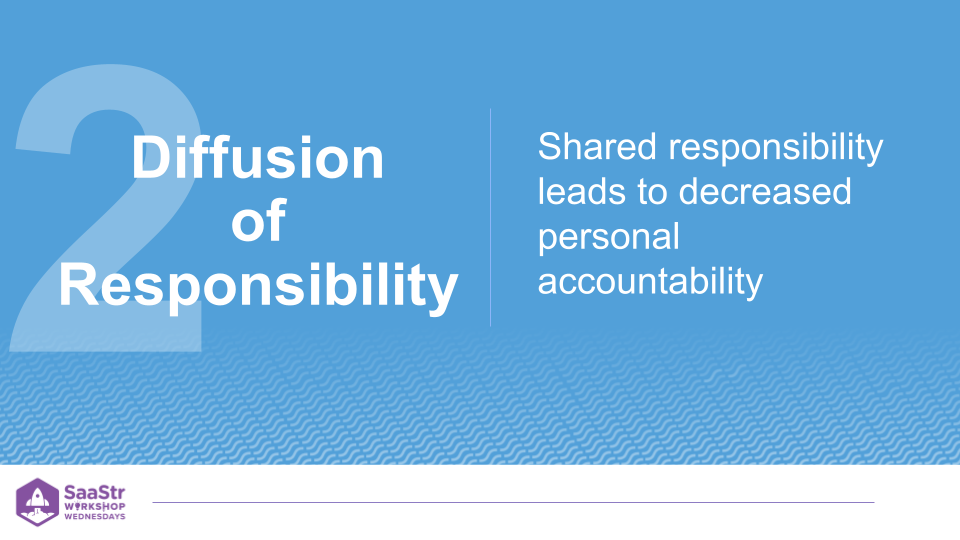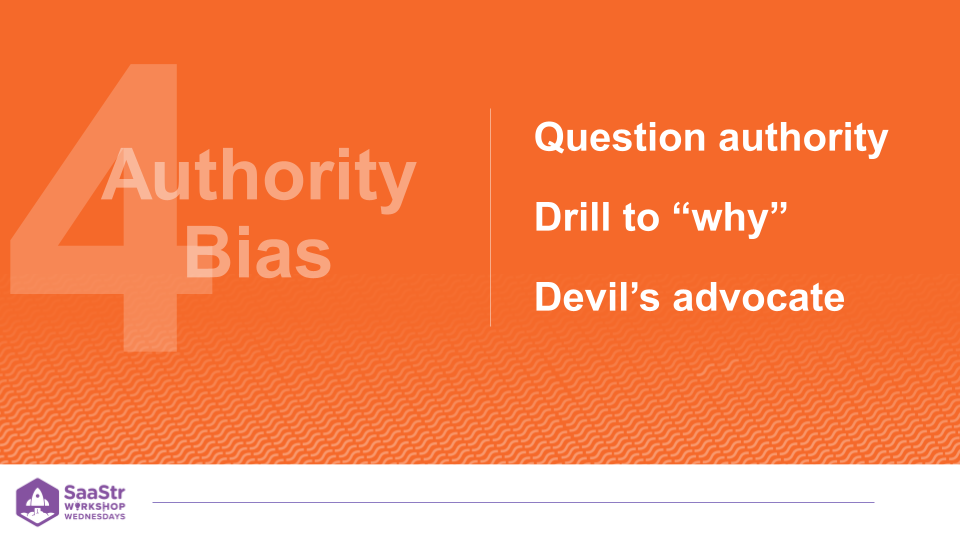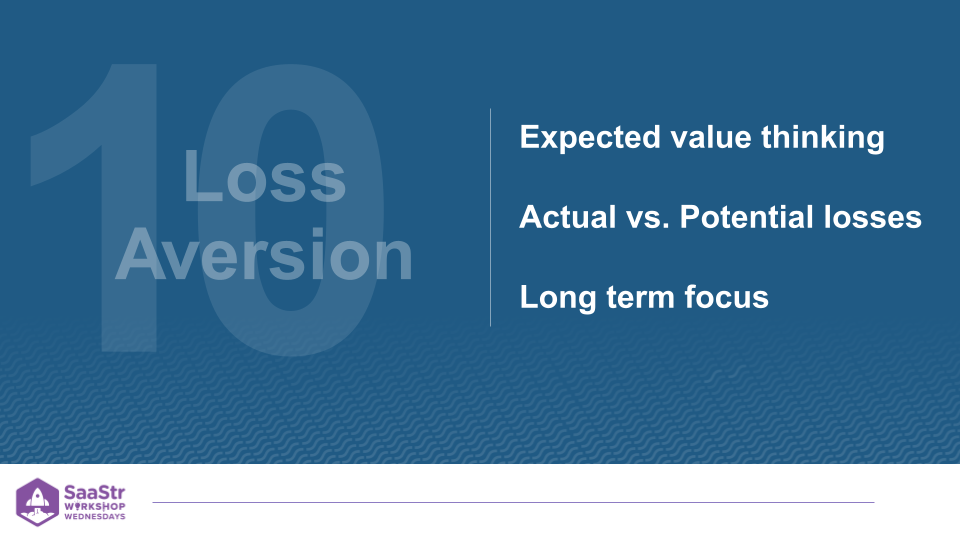Board meetings –– why do they sometimes feel like such a chore? Or worse, why do board meetings sometimes go so poorly?
The answer is simple. Your board of directors is a group of people, and when in groups, predictable behavior patterns can cause negative outcomes. However, with a basic understanding of social psychology, it’s easier to manage the group and get more productive results from board meetings.
In a special Workshop Wednesday session, Josh Stein (Founder & Managing Partner at Threshold VC) and Katie Evans (Investor @ Threshold VC) share ten secrets for great meetings.
SaaStr Workshop Wednesdays are LIVE every Wednesday. Sign up for free.
1. Cognitive Biases
Cognitive biases are systematic errors in thinking and decision-making due to mental shortcuts. These mental shortcuts are beneficial in everyday life –– they can help us operate faster and make decisions more efficiently. But sometimes, these shortcuts can cause problems for us, especially in business. They prevent us from thinking through a situation in its entirety, which can lead to poor decisions.
The Fix:
- Acknowledge: Firstly, acknowledge that these biases exist. Awareness is key. Evans says, “Being aware of biases and their impact on decision-making really does help fight that automatic nature of cognitive biases.”
- Understand: Ensure you educate yourself about various biases and their effects. How does your bias impact business decisions and dynamics between colleagues? There are over 180 cognitive biases, so learn as much as you can about them.
- Overcome: Make deliberate efforts as a business leader that help your board overcome these biases to establish the best decision-making process and spur the correct actions.


2. Diffusion of Responsibility
Shared responsibility leads to decreased personal accountability. Consider an example you may have encountered before: A company meets with a large group of stakeholders. Perhaps the group agrees that collective action must be taken, but then nothing happens. This is due to a lack of accountability for individuals in a large group. Stein explains, “The larger a group gets, the less any one individual feels accountable for the result or the outcome. So basically, the responsibility gets diffused out.”
The Fix:
- Active Leadership: Take a hands-on, visible approach in guiding board meetings. Remain accessible, visible, collaborative, and communicative.
- Team Size: Evans encourages leaders to “Be sure you’re keeping team size manageable for more productive conversations.”One of the simplest ways to keep team size manageable is to think about who actually needs to be at a meeting before it starts and specifically what role each attendee will play.
- RACI Framework: Consider using a tool like the RACI Framework. RACI stands for Responsible, Accountable, Consulted, and Informed, and its purpose is to help clarify rules and responsibilities for those in meetings.
3. Dunning-Kruger Effect
The Dunning-Kruger Effect occurs when incompetent individuals overestimate their own competence. The phenomenon also works both ways: Individuals with low competence overestimate their competence, while individuals with high competence underestimate themselves.
When the Dunning-Kruger Effect occurs in a board meeting, it can kill the energy and make people feel alienated.
The Fix:
- Value Experience: “It is critical to align airtime with expertise. This might be the biggest single responsibility of the board chair or meeting leader,” Evan explains. Don’t simply let the loudest voice in the room steer the conversation.
- Value Inexperience: Avoid only giving the top experts all the time. Sometimes, less experience means a new perspective that can challenge the status quo.
- Solicit All Views: For the most informed decision, ensure all opinions are heard.


4. Authority Bias
Authority bias happens when there is an excessive reliance on the opinions of authority figures. People tend to feel uncomfortable speaking to an alternate view of an older person or an authority figure. But in business, multiple perspectives are good; as we can see in today’s market, things change and move quickly.
The Fix:
- Question Authority: Create a culture where critical thinking is encouraged, even if it ends up being wrong.
- Drill to “Why:” Ask the five “whys.” Asking why five layers deep helps expose either validity or invalidity of an argument.
- Devil’s Advocate: You can appoint someone in a devi’s advocate role. This helps calm any potential tension from speaking up, and the person will likely feel they can speak more freely.
5. Conformity Bias
Conformity bias is the tendency to conform to group norms or opinions. This is natural behavior, of course, evolutionarily speaking. We all have an instinct to go with the herd. However, this is not always helpful for board meetings. Stein explains, “Conformity bias is a great way to have a not transformative company and end up with a very mediocre result in technology.”
The Fix:
- Set Good Norms: A good leader will set the standard that voicing a dissenting opinion is normal and, sometimes, rewarded.
- Encourage Debate: By encouraging healthy debate, you will bring multiple points of view to the forefront and encourage everyone to review materials more closely and prepare more carefully before a board meeting.
- Cold Call: If there isn’t much discussion, it never hurts to “cold call” or ask an individual directly if they agree with the group consensus. You may even want to pull them aside later and ask whether they felt comfortable speaking up.


6. Anchoring Bias
Anchoring bias is the reliance on the initial information we receive when making judgments.“We have a very strong predisposition to anchor on the first piece of information or early pieces of information that we’re given…the order in which you present information and the order in which you put data forward matters a lot,” Stein says.
The Fix:
- Consider All Data: Avoid building your point of view on the first thing you hear. Wait until you receive all relevant data before making decisions.
- Challenge Initial Information: Actively challenge the first information you receive. Make this a habit throughout your professional life.
- Delay Judgment: Avoid snap judgments until you’re certain you have all the information.
- Compare Alternatives: Consider alternative points of view: what if you had learned something else first? Would that change your perception?
7. Confirmation Bias
Confirmation bias happens when we favor information that confirms our pre-existing beliefs. It’s an insidious tendency because we believe facts back up our opinions, but often we leave out evidence that challenges our original assumptions.
The Fix
- Recognize Biases, Diversify: Simply being aware of this helps as a first step. Don’t keep cherry-picking data to prove your point.
- Question, Seek Evidence: Learn to question your original opinion and seek evidence to the contrary if possible
- Think Critically, Learn: Think critically about what you believe to be true versus what you know to be true. Challenge the assumptions of others as well as yourself.


8. Hindsight Bias
They say that hindsight is 20/20, but sometimes reflecting on the past brings up some gaps in understanding. Hindsight bias is believing past events were more predictable than they were.
We think we have great memories about what happened in the past, but it’s often not true.
Understanding what information was knowable in the past, because that’s critical for improving the process and trajectory forward. Important to distinguish so you can’t punish people for things they could not have known.
The Fix
- Intellectual Honesty: Be honest with yourself and the board –– was what happened actually avoidable? Or does it simply seem that way now? Do you remember things accurately? Avoid giving credit or punishing people over unknowable information.
- (Un)known Unknowns: You can fault someone for not digging deep enough or ignoring things that they could have prepared for in advance. These are “known unknowns.”However, be careful to understand the difference between someone doing their due diligence even when unpredictable circumstances arise, which are truly “unknown unknowns.”
- Process Over Results: Focus on the process rather than blaming people for poor results. Use what you learn to build better paths forward.
9. Externalization of Blame
As its name suggests, the externalization of blame happens when you blame external factors rather than accepting personal responsibility. When things don’t go well, it’s tempting to find someone or something to blame. That, combined with hindsight bias, can discourage teams from taking prudent risks.
The Fix:
- “We” vs. “They:” Often, when something goes well, people use the word “we.” For example, a sports fan may say, “We won the game last night,” or a CEO may discuss a strong sales performance by saying, “We had a great quarter.” But when the outcome is not positive, people tend to use the word “they.” (“They lost last night” or “The sales team didn’t have a great quarter.”) Embrace collective responsibility and avoid the “we” vs. “they” mentality.
- Solutions > Problems: Instead of focusing on blame and deflecting responsibility for problems, focus on finding solutions for the future.
- Process vs. People: Once again, direct attention to improving a process, not blaming or praising your people.


10. Loss Aversion
Loss aversion is the preference to avoid losses over acquiring equivalent gains. Once we have something, we hate losing it. After a while, we derive about half as much pleasure from gaining than losing something. This is why big companies can get apathetic, and startups are likelier to make bold choices.
The Fix:
- Expected Value Thinking: Firstly, challenge yourself when you get worried about a decision: what is the cost of this action, and what is the price of inaction? Both will have consequences, but there will be a cost to doing nothing.
- Actual vs. Potential Losses: Ask yourself, “What is the actual probability of that potential loss?” This can help you combat the fear of risk.
- Long-Term Focus: People assume the world is more static than it is, requiring movement and innovations. Stay dynamic, and your success will continue.


Key Takeaways
- Keep meetings and team sizes manageable, and use the RACI framework to ensure ownership of actions.
- Avoid blaming people for unpredictable obstacles, and focus on the process.
- Take on a “we” mentality instead of a blaming mentality.
- Ask yourself what the price of action vs. inaction is. Are you letting fear dictate your decisions?
Every Wednesday at 10 a.m. PT, SaaStr holds live, interactive workshops where experts in the community share their insights. Sign up for free HERE!
- SEO Powered Content & PR Distribution. Get Amplified Today.
- PlatoData.Network Vertical Generative Ai. Empower Yourself. Access Here.
- PlatoAiStream. Web3 Intelligence. Knowledge Amplified. Access Here.
- PlatoESG. Automotive / EVs, Carbon, CleanTech, Energy, Environment, Solar, Waste Management. Access Here.
- BlockOffsets. Modernizing Environmental Offset Ownership. Access Here.
- Source: https://www.saastr.com/10-rules-of-the-boardroom-with-threshold-vc/



